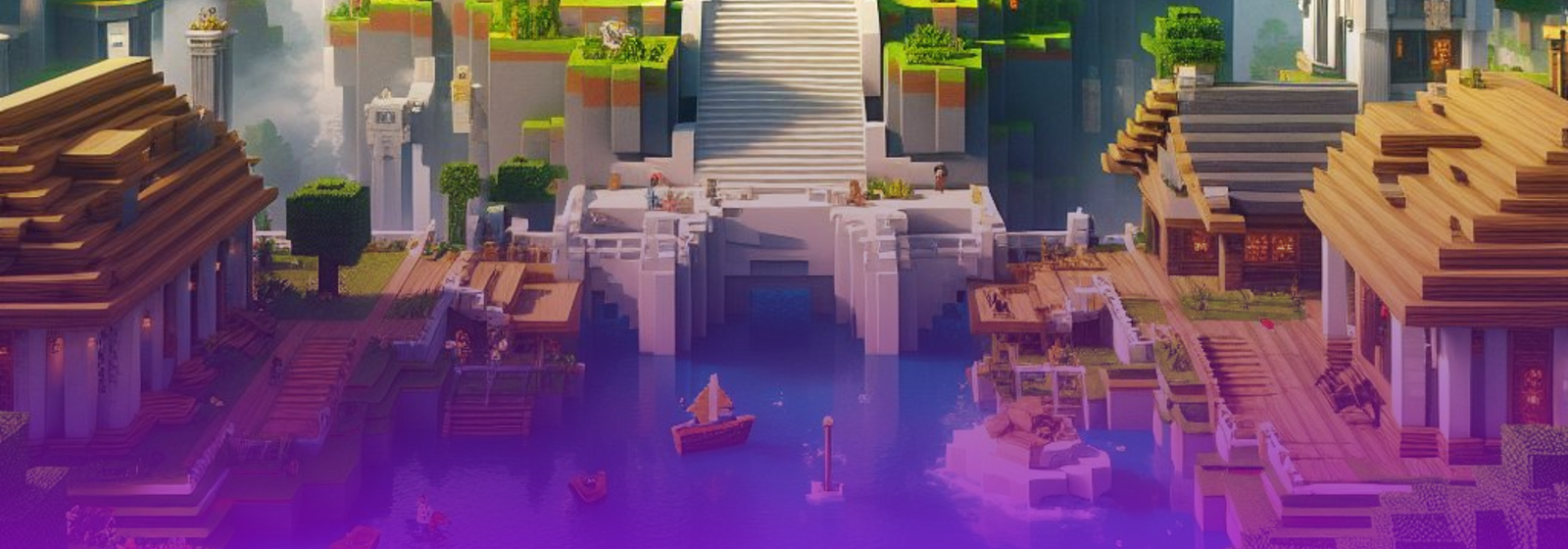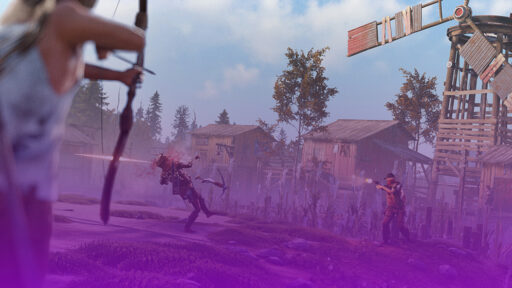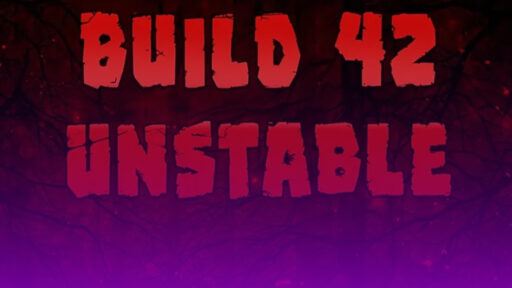If you’ve ever played Minecraft, I am sure you’ve heard the words “mods” and “plugins.” Maybe you asked yourself, “What’s a mod, what’s a plugin, and what’s the difference?” Both mods and plugins can be used to enhance your server. Still, they are used for different purposes and operate in various environments – for example, mods require players to install them on their game client. In contrast, plugins run directly on the server and work without needing players to change their game client. Let me walk you through the differences between mods and plugins, and explain how they differ.
What Are Mods?
Mods are game code modifications that allow players to add new features, mechanics, or items. They’re typically created for single-player, but many can also be used in multiplayer. Mods have the power to alter your game experience: you can either play a regular vanilla version with some new items or play a very realistic version of Minecraft that gives you a different experience by changing your graphics, adding new mechanics, and a lot more functions.
Minecraft Mods started to appear right after Notch (the creator of Minecraft) released the alpha version of Minecraft around 2010. The first popular mods were made around 2010-2011, when players began modifying the game’s code directly. After a short period, developers started to develop tools such as “ModLoader” and Minecraft Forge.
Now you may wonder, why were mods invented? Here are the main reasons:
- Customization: Players wanted to change Minecraft to their preferences, either by adding new content or changing game mechanics.
- Expanding Gameplay: Mods introduced new gameplay styles like adding new biomes, items, mobs, etc.
- Fixing Limitations: Early versions of Minecraft were limited and had a lot of problems, but mods managed to fix these issues and remove the limitations. For example, the game originally had a small selection of blocks, no minimap, no advanced redstone logic, and very basic world generation. Mods like TooManyItems (now it’s called JustEnoughItems) added inventory control, OptiFine improved performance and buggy graphics, and IndustrialCraft introduced complex machinery and automation systems – features that were completely missing from the base game.
- Community Creativity: Minecraft encouraged modding from the start, and many developers joined to express their creativity and be recognized for their work.
Pros and Cons of Mods
Pros:
- Customization: With Mods, you can create something truly unique, a world made by your preferences. You’re not limited to what the base game offers. Want to live in a medieval kingdom or tame custom dragons? Mods make it possible. They let you design new items, creatures, dimensions, and mechanics, turning your Minecraft experience into something that’s entirely your own.
- Wide Range: There is a wide range of mods you can try, from ones that add a single new item to others that introduce insanely custom-made dragons. Whatever you’re thinking about, there’s probably a mod for it.
- Client-side: Some mods are client-side, meaning they only show and work for the specific user and not the rest of the players. This gives players an advantage; imagine using a schematic mod to view a blueprint that helps you build a beautiful house, but only you can see the blueprint. Sounds cool?
Here is an example of what I mean. As you can see, I have a blueprint of a house that only I can see, while the other players cannot.
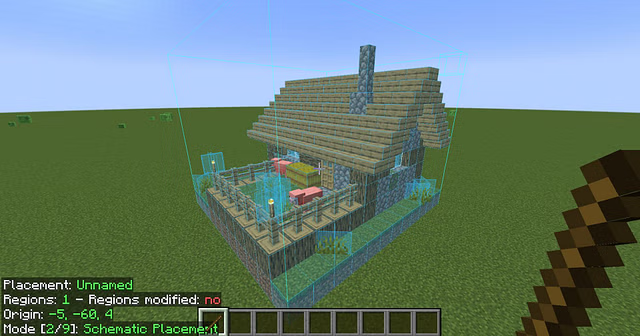
Cons:
- Installation Difficulty: Installation varies from mod to mod, and it can be tricky, especially if you are unfamiliar with mods. Every mod needs to be compatible with the game version, and the user needs to install the mod on their computer along with a custom profile (on the Minecraft Launcher), either Forge, Fabric, NeoForge, etc.
- Issues of Compatibility: Not all mods are compatible. Sometimes your favorite mod will not work with another one, leading to crashes or glitches.
Mods Popularity
Mods have grown super popular over the years, with tons of players using them to improve or completely change their Minecraft experience. Here are some of the most popular mods on CurseForge right now.

You can view them on CurseForge Official Website.
What Are Plugins?
Plugins, on the other hand, don’t modify the game itself; they extend or customize the server behavior without changing the game client. Plugins run solely on the server, which means you do not need to install files onto your computer (client-side). Plugins started to appear shortly after mods appeared, during the early days of Minecraft’s multiplayer development. When servers became very popular, admins needed better control, customization, and protection tools. This led to the creation of hMod (Hey0’s Mod), released in 2010. This allowed developers to make their custom plugins. After hMod was discontinued, Bukkit was created in early 2011, and it became the standard API for servers.
Now, you may ask yourself, “Why were Plugins created?”, and why did people want to use plugins? So here are the main reasons:
- New features and Customization: Plugins were primarily made to give server owners the ability to customize multiplayer servers without modifying the game client. They also added new features such as permissions, ranks, warps, economy systems, and anti-griefing tools.
- Server Performance and Optimization: A big portion of plugins were intended to optimize performance, limit entity behavior, and control the server using commands.
- Automation and Scripting: Some plugins gave admins the possibility to automate tasks (e.g., auto-restarts, backups, filtering the chat). This saved a lot of time and work for admins.
Pros and Cons of Plugins
Pros:
- Ease of Use: Plugins are simple to install and typically have simple interfaces for your server management.
- Server-Based Modifications: Since they were designed specifically for servers, plugins are perfect for enhancing multiplayer gameplay. You can add plugins that manage player ranks, create custom worlds, or include chat commands. It is essential to mention that plugins don’t require the player to install them on their computer; they are just in the server files.
Cons:
- Limited Scope: Plugins can add massive multiplayer value, but they might not be as powerful as some mods regarding gameplay alterations. Plugins cannot add anything new (including items, mobs, biomes) other than changing the server code behavior. They only work on vanilla items, entities, and functions.
- Server Dependence: To make maximum use of plugins, you should have control over the server; you can’t add plugins to a server without having access to the server files.
Plugins Popularity
Plugins have become essential for Minecraft Servers, helping customize gameplay, manage players, and add cool features. Here are some of the most popular plugins from Modrinth.
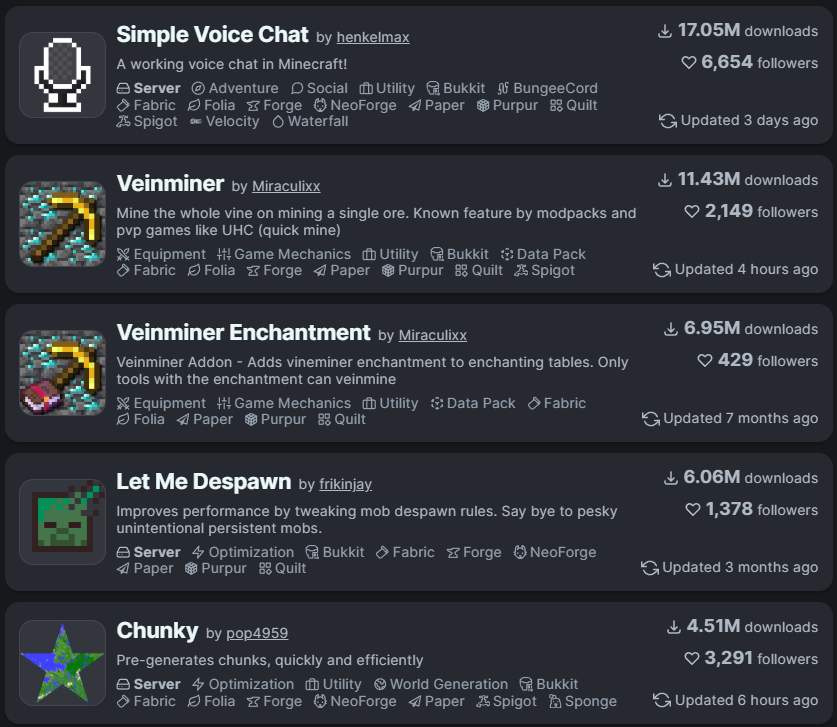
You can view them on the Modrinth Official Website.
Breakdown on Mods and Plugins: Different Loaders
What are loaders, and how do they work?
A loader is a software tool that allows mods to be loaded and run in the game; they also manage how mods interact with Minecraft. Loaders are the middleman between you and the game. You tell the loader which mods you want to use, and it starts Minecraft with those mods already loaded, so you get a modded version of the game ready to play.
There are a lot of different loaders on the internet, which have different modules and functions. Here are some of them:
- Vanilla: This loader is just the regular, unmodded version of the game; the way Mojang made it. It doesn’t have any extra features or custom stuff, but it’s stable, simple, and works exactly as intended.
- Forge: This is a more complex loader widely used for large and complex mods. This loader can sometimes be slower, but more effective than the others. Forge is considered more effective because it offers extensive tools and deeper integration options that enable developers to build large and complex mods with the help of their API. Forge usually takes longer to update to the latest Minecraft version.
- NeoForge: This is a fork of Forge created by a Forge developer after some disagreements (the specific developer said this on their Official Site). NeoForge is more modern than Forge and provides a more efficient experience for mod developers, thanks to the cleaner code, better tools, and flexible API’s. This loader also updates faster than Forge and has better performance.
- Fabric: This is a lightweight loader, faster and more efficient than the rest. Fabric is mainly used for client-side mods (mods that affect only the client and not the rest of the players).
- Paper: This is a Server loader that is different from the rest and is made for Minecraft Servers to use plugins (not mods). Paper is a high-performance loader that supports Bukkit and Spigot plugins.
- Bedrock(Vanilla): This is the primary loader that Minecraft Bedrock Edition uses for Windows version, mobile, console, etc. This loader makes the game feel smoother and can run on less powerful devices. Bedrock doesn’t permit adding mods, but it allows the user to use add-ons (users make add-ons, but they need to be approved by the Minecraft official developers)
- Velocity: This is a Proxy whose primary purpose is to connect multiple Minecraft Servers. This Proxy can become a Server Proxy, whose main purpose is to switch players between minigames, hubs, etc. It’s lightweight, modern, and made for large Minecraft Servers. Velocity is used for large Minecraft Servers because it’s specifically designed to handle high traffic, fast connections, and transfer players securely between multiple backend servers.
If you ever want to try any of these loaders, you can use our Minecraft hosting. Prices start from $2.99. Cybrancee.com
Mods Or Plugins? Which One Should You Choose?
Finally, the choice between mods and plugins depends on how you want to play Minecraft. If you are a person who enjoys tinkering with new mechanics, exploring new biomes, fighting insane mobs, or completely changing how the game works, then mods are your best choice. They’re perfect for players who love deep customization and adding entirely new dimensions, creatures, and items. Want to go to space? Ride dragons? Automate everything? Mods can do all of that and more.
But if you’re planning to build a multiplayer server, run the next largest community, or just have some fun with your friends, plugins are probably the smarter choice. They’re easier to manage, don’t require players to install anything, and they are perfect for adding server features like ranks, shops, homes, teleportation, or even full game mods like SkyWars or BedWars. Plus, they keep the gameplay close to the original while giving you full control of it.
There’s no rule saying you can’t enjoy both. Some of the best servers combine them using setups like Forge + Sponge or Fabric + modded proxies.
So, whether you’re battling monsters in a custom modpack or running the next largest Minecraft community, both mods and plugins give you lots of options.
Happy building!

